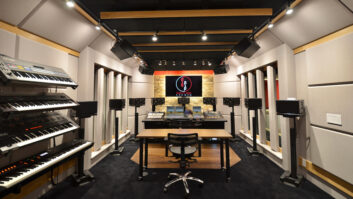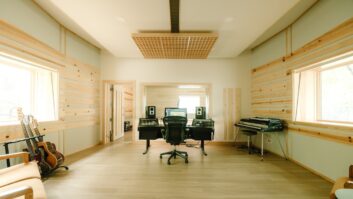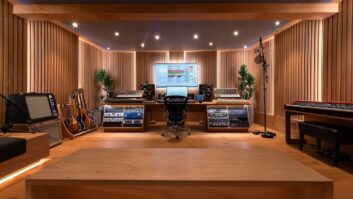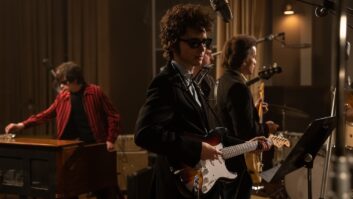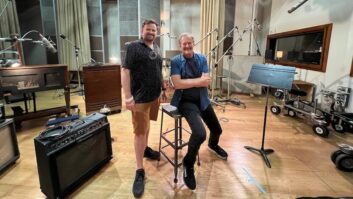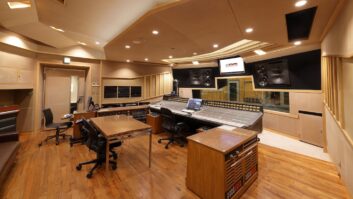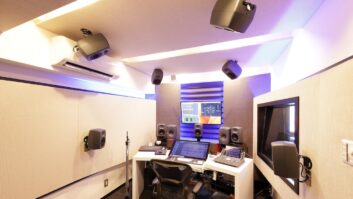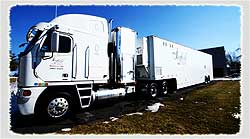
The Sheffield remote truck
Editor’s Note: This is the fourth installment in our new online series written by and for mid-level studio owners. On a monthly basis, Studio Unknown owner Kevin Hill and creative director Lisa Horan will be calling around the country and bringing their own expertise to the issues that matter most to a successful studio life. Let’s face it, the middle has been hit hard in the economic downturn, but it’s also the middle that is most likely to come roaring back. As Mix’s February 2010 issue looks at the changing market in remote recording from the perspective of well-established mobile studio businesses in the feature “Shifting Gears,” Horan and Hill turn to mid-sized studio owners who are also engaged in remote recording for their perspectives.
With all the talk about diversification this year, it would seem like venturing into the parallel world of remote recording would be a logical move for studio owners, right? The answer, unfortunately, is not a simple yes or no. While there are certainly advantages to branching out into this potentially lucrative business, studio owners must consider a lot of prerequisites before taking the leap. This month, we talk to studio owners for whom remote recording is a significant percentage of their businesses, and they get down and dirty about the realities, the financial implications and the possibilities for those entertaining the idea of going mobile.
Kevin Clock of Colorado Sound Studios
Money Talks
You’ve done some live sound for local venues with success and you’re ready to take a step up. Getting your hands on a nicely outfitted truck to cover acts at major venues seems like a natural progression, and it is, just as long as you understand what you’re getting yourself into. “The reality of today is that you’re talking probably $500,000 to a million dollars-plus to build and outfit a good remote truck,” says Vance Van Horn, the president of Phoenix, Maryland’s Sheffield Audio Visual Productions. The company’s 48-foot audio remote truck, which was purchased roughly 10 years ago, is one of the most highly sought mobile studios on the East Coast and has been involved with major shows from the MTV Music Awards to the Super Bowl. Even for an upper-mid-sized company like Sheffield, which has been in the business for 35 years, this kind of purchase is no drop in the bucket.
And the outfitting is only part of the equation. With crimps in many companies’ pocketbooks, just about everyone is cutting back, which means that many clients are less likely than ever to be able or willing to pay top dollar for remote services. “The remote side of the business did drop off a lot this winter, but the good news is, it looks like we have some great gigs coming up in the spring and summer,” says Kevin Clock, the owner of Colorado Sound Studios and co-owner of its partner company, toybox remote recording, both based in Denver. Toybox operates a 24-foot truck that costs $3,000 per day with a crew of four. “We get a lot of calls, but either potential clients want extreme discounts, or the call is from another part of the country and it would cost too much in travel expenses, so we have to turn the jobs down.”
“A lot of owners have the mentality that if you build it, they will come,” adds Van Horn, “but 75 percent of the time, that doesn’t happen, so you have to carefully consider that possibility.”
On top of that, every studio owner finds himself or herself in the position of having to upgrade, upgrade, upgrade—and remote equipment is no exception. “The more gear you have, the more maintenance you have, and the more computer updates you have to take care of,” explains Clock. “And with remote equipment, you tend to have even more maintenance than studios because the gear gets bounced around and can face more extreme temperature variations,” adds Clock, who says the company will soon be updating its computers by adding the Snow Leopard OS. “Our console will be 10 years old soon, and we’ll have to look at updating it with newer technology,” says Van Horn. “The truth is, if you want in, you’d better be willing to afford it, and you’d better love the idea of being in the business rather than the notion that you’re going to be making a million dollars.”
Speaking of Business
Having a keen business sense definitely comes in handy if you’re a studio owner. In today’s industry, you must use that business sense to recognize change and be willing to adapt to it—even if that means completely revamping your business plan. That’s exactly what Mark Kirchner, co-owner/VP of San Diego, Calif.’s Studio West had to do: In 2004, Kirchner started a gear rental company, Edit System Rentals, as an extension of his recording studio. “The idea was to rent Avid Media Composers and Pro Tools systems to existing facilities, but what ultimately happened was that clients began buying their own rigs and the rental business began drying up,” he explains. The demise of one business, however, led to the birth of another. To compensate for the shift, Kirchner began partnering with studio clients who also needed equipment for their tours. “I worked hard to forge relationships with local venues and artists so that I could keep my gear out there, and what ultimately resulted was a successful remote recording business.” Today, in addition to the 8,000-square-foot studio that Kirchner co-owns with Peter Dyson, the remote recording business he operates accounts for roughly 20 percent of Studio West’s business—but only because Kirchner recognized a dead end and took the necessary steps to pave his own way. (The company also operates a Digidesign Certified Pro School: The Recording Arts Center in San Diego.)
Engineer Steve Colby, Sheffield EIC Tom Kline and legendary producer John McClure at the Boston Pops
Van Horn, who has been a part of the Sheffield team for 30 of its 35 years, says this willingness to change business models is imperative to survival. Even though Sheffield’s truck is successful, Van Horn says the company has “consistently changed our business profile every five to 10 years since I’ve been here.” This, he says, is the only way to survive. “When we first started and record companies were able to spend $100,000 on records, that was a big part of our business, but as the industry has changed over the years, we’ve had to change with it.” Since the 1970s, Sheffield has tried its hand at video production, video remote production, and remote audio recording for sporting events. The company currently also encompasses the Sheffield Institute for the Recording Arts, which provides vocational instruction and hands-on-training to aspiring students of audio, video, broadcasting and systems integration.
In addition to understanding and following the trends of the industry and being willing to make changes when necessary, Van Horn says one of the most important and wisest decisions the company ever made was to build slowly. “Many owners tend to jump head first into new areas and grow too fast. The problem is, things don’t always turn out as you think, so you have to make sure you put up as many safeguards as you can just in case.” Van Horn points to the multitude of production companies that sprung up in the Washington, D.C., area, when National Geographic and Discovery Communications entered the scene. Unfortunately, these companies invested a great deal of money in equipment, believing that they would get work from these outlets, but because both wound up doing much of their production work in-house, it just didn’t happen at the rate these companies had hoped or planned for, and their investments did not pay off.
Speaking of investing, each owner we spoke to cautions against taking the plunge into purchasing a remote truck in today’s economy. “I would strongly discourage buying a truck right now if you don’t have the clientele or the experience in remote recording already,” says Clock. “Starting from scratch in the economy we’re in right now would definitely be difficult, but if you do want to pursue remote recording, there are other options that may make more sense other than buying a truck.”
Studio West is a good example. While the company lands major jobs in remote recording, it does so without a truck. “The remote system we built enables me to load all of the gear—Pro Tools system, Mackie back-up recorders, an assortment of pre’s, splitters, etc.—into my [Ford] Expedition by myself and set it up without a second person,” says Kirchner, who has worked with clients such as Dave Matthews, Eric Johnson and Regina Spektor, and is able to handle large venues with as many inputs as the big trucks. “Whereas many clients can’t afford the $7,500 per day price tag that is attached to the large trucks, they often can pay $2,500 for our services, so we’ve been able to put our hand into remote recording without having to invest in a truck.”
The Good News
For all of the challenges involved with venturing into remote recording, there is obviously a sunny side, or studios wouldn’t be doing it. For instance, one benefit is the notoriety that it generates. By having a presence at venues, studios are able to put their name out in front of potential clients, win new clients, and, as a result, produce an extra source of income. “Being out there in front of people really helps us to foster important relationships and keep our studio booked,” says Kirchner. It’s also enables him to be involved with some exciting projects that transcend live music. For instance, both Sea World and the San Diego Zoo are two of the company’s bigger, consistently returning clients. For Clock, one of the biggest payoffs is in the “feeling” remote work gives him. “Once you get everything set up and get your audience mics mixed in, what a great feeling to hear a killer live performance, then ride up the audience faders and hear their roar. It’s pretty cool,” he says. “Now, the thrill of capturing live recordings is in my blood. For me personally, it’s a nice getaway from the studio, where you have to pick at each and every note.”
Top Tips for Running a Successful Remote Recording Division
1. Make sure you can afford good-quality equipment.
2. Check, re-check, and re-check equipment again. “Just one crash can mean a pretty big dent in your reputation,” says Mark Kirchner, co-owner/vice president of Studio West.
3. Be willing to test the waters. “Start slow and avoid the temptation to jump in too fast before really knowing what you’re jumping into,” says Vance Van Horn, president of Sheffield Audio Visual Productions.
4. Don’t underestimate the value of good partnerships. “Don’t burn bridges with other studios around town. Having a good relationship with them may come in handy if you are in need of a piece of equipment or other help at a critical time,” says Kirchner.
5. Put in the extra effort by visiting venues before shows, introducing yourself to staff, and getting the lay of the land.
6. Have a firm, but amenable personality. “When you are running a remote truck, you have to be somewhat demanding because you need to make sure everything is just right so that you’ll get the result you need, but you’ve got to treat people right and show respect. There’s a fine line,” says Kevin Clock, owner of Colorado Sound and co-owner of toybox remote recording.
